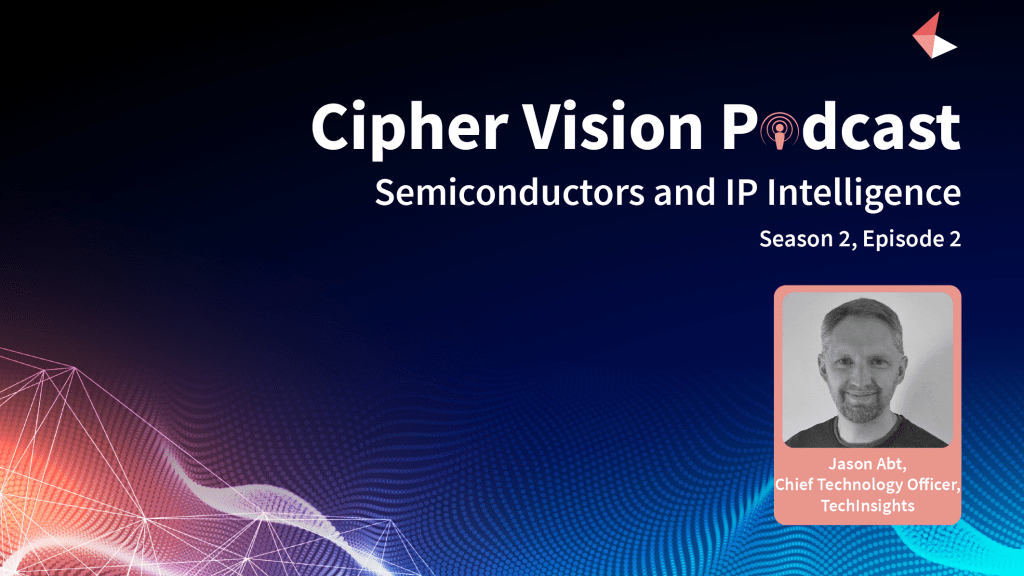Semiconductors and IP Intelligence

Guest:
- Jason Abt, Chief Technology Officer, TechInsights
Episode Highlights
We actually started way back in the late 1980s, where originally the core team was based in a company called Mosaid. Mosaid was a company that was developing technology for computer memory devices. They had a product, but they really excelled at the design stage and they wanted to make sure that they protected their IP investments. They actually formed a small group of engineers to take a look at other products in the industry and compare them with Mosaid’s intellectual property to see, ‘is anybody potentially infringing on our patents or going in a direction where they might be infringing?’.
It got to the point where the investors were actually looking at this team and wondering there’s probably an opportunity to take this kind of expertise and this kind of approach more broadly to the market. So the team was actually spun out into an independent organization called Semiconductor Insights at the time. It was designed to support the semiconductor industry. When an organization with intellectual property is looking to protect their IP investment, there’s often some kind of forensics involved. The forensics can be fairly straightforward, you take a look at the product and take a look at a patent and you think, ‘there’s a lot of similarities here, we should probably talk to a lawyer and see if we should be having a licensing discussion.
When you get to the chip level, it’s really hard. You can’t just take a screwdriver and pop the lid off a microchip. It doesn’t work that way. So semiconductor insights at the time, developed a broad range of technical expertise to do the forensics needed to compare, again, patent versus product in the semiconductor industry.
Tearing down a chip
Microchips come in all shapes and sizes, but they are small. They could be as large as your thumbnail, all the way down to the end of the sharp point of a pin. On the chips are electrical switches and wires that are at a really small scale. If you were to pluck the hair off of your head, it is roughly about 15 micrometers. So you would actually have to divide that about 10,000 times to get to the width of one of those electrical switches. Obviously, you can’t see that with a human eye. You need some very sophisticated tools to reveal these electrical switches without damaging them. You need some sophisticated microscopes to actually see those switches and those wires. So that forensics piece of it is highly specialized and that’s what TechInsights excels at.
Patents as an informative resource
Our customers want to see what’s going on in the market today, but what they really want to understand is what’s going to happen in the market tomorrow. Patents are, by definition, a teaching tool. When a company is putting a patent out there, they are, of course, protecting that IP investment, they’re also teaching people what it is that they did. The core value of the patent system is to be able to build on others’ ideas and inventions. What we see is that patents are a great proxy for what’s happening in R&D, in organizations, in the semiconductor industry and other industries.
So if you look at patents in the right way, if you can get beyond the single patent and look at it from a landscape, a holistic standpoint, you can start to see trends. Those trends can actually point you to understand what is going to be happening in the future. If we see a patent application today, there’s a good chance that we’re going to start seeing some of that functionality, some of the innovation, in products two, three, four years down the road.
Semiconductor Industry Trends
Very few people really predicted what the last couple of years were actually like. The level of interest in a semiconductor supply chain – I’ve never seen it before. Chips are in absolutely everything from our phones, our gaming consoles, all the way to our toasters. The supply chain challenges have triggered a number of cascading challenges. There is a lot of interest in building out manufacturing capacity for chips,. What’s challenging is that the bleeding edge of semiconductor manufacturing is really expensive. To build one of these factories is a tens of billions dollar investment, it’s pretty hard for an organization to put that down unless they’re really serious or very well established.
What has been happening for a long time in the industry is most chip companies don’t actually manufacture their own chips. Most chip companies design the chip and then work with a foundry service or application service to actually manufacture them. Where it starts getting difficult is to understand what the holes are in their intellectual property.
Rewinding all the way back, one of the ways to help identify who could supply the needed IP to fill those holes is to manually go through and do some keyword searches. But what if you could elevate to a higher level? What if you could holistically at specific technology areas and let the platform do the work? This is one of the areas where the Cipher platform can be a huge assistance.
Message from the CEO
At the heart of the fourth industrial revolution is connectivity, with an estimated growth from 14B connected devices today to 30B by 2025. This puts semiconductors and microelectronics at the heart of the technology landscape. Both the scale of investment required and the economic payoffs are huge. Investment in IP and specifically patents are critical to ensuring that those who invest in R&D are fairly rewarded.
Intelligence of the quality produced by TechInsights is critical to achieving the transparency required and Cipher is proud of its partnership with TechInsights as we accelerate and simplify access to the 10000s of patents that will define the future.

Looking for new ways to classify patent data and create bespoke technology clusters?
Find out how you can use the LexisNexis Cipher Classification system to read 44m+ patents globally and pull the relevant patents into a classifier defined by you and avoid the hard work of going and finding the right patents.
